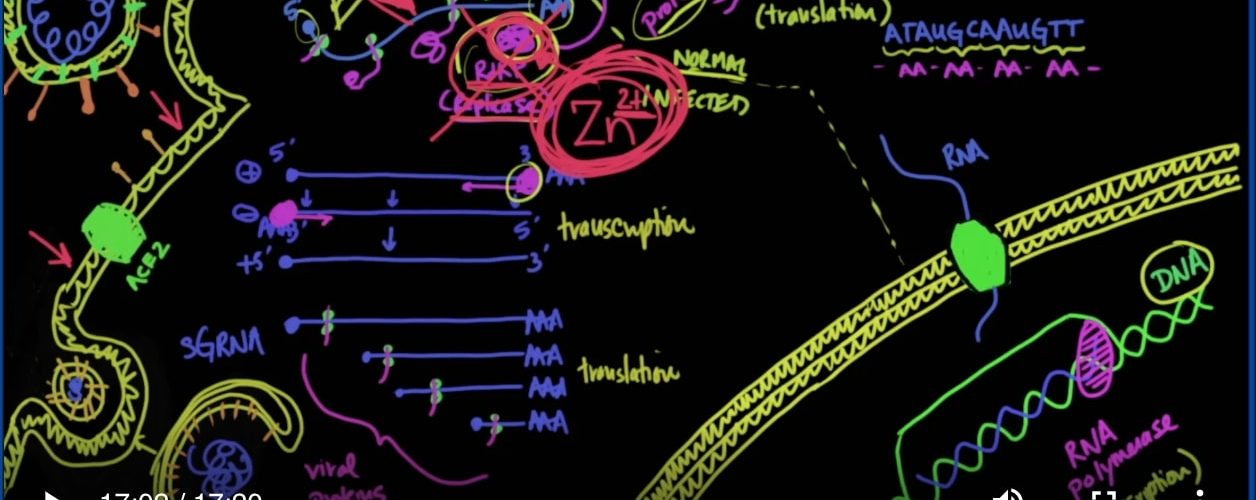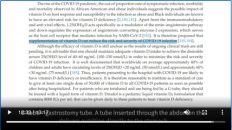氯喹助锌进入细胞,靶向控制新冠病毒复制 (新冠肺炎讲座34)
Cases Surge, Chloroquine and Zinc Treatment Combo, Italy Lockdown (Lecture 34)
Welcome to another MedCram covid-19 update. We see here that the total recovered is 16 times that of the total deaths, and we can see here that the Active Cases are once again starting to come back up again. That’s because of the activity outside of China.
欢迎来到MedCram covid-19的另一个更新。我们在这里看到的康复总数是死亡总数的16倍,并且在这里我们可以看到,活跃病例又再次开始恢复,那是中国以外病例的原因。
In terms of today, March 10th, we can see that there are a number of cases in multiple countries all over the world. Of course, the news from yesterday is that Italy has decided to extend its lockdown to not just the north of Italy but to all of Italy.
就今天(3月10日)而言,我们可以看到世界上许多国家都有许多病例。当然,昨天的消息是意大利已决定将封锁范围不仅扩大到意大利北部,而且扩大到整个意大利。
In terms of yesterday in Spain, the number of cases has essentially doubled, with 557 new cases, and that seems to be a new hot spot.
就昨天的西班牙而言,病例数量已基本翻了一番,有557宗新案件,这似乎是一个新的热点。
I can tell you as of yesterday, I was able to get a lab test out of a commercial test company that I needed to have done in a patient in the emergency room. So I’m hoping that that is going to increase dramatically here in the next week or so.
我可以告诉您,从昨天起,我已经能够从一家商业测试公司获得一份实验室测试,而我需要在急诊室的一名患者中进行该测试。因此,我希望下个星期左右,这种情况会急剧增加。
We’ve talked about zinc here a couple of updates ago, but the story is not done. It’s kind of an exciting story that gives me some cautious optimism in terms of covid-19, but to understand this better, we’ve got to go back and look at the molecular biology of the cell once again.
我们之前在这里讨论了锌的一些更新,但是故事还没有完成。这是一个令人兴奋的故事,使我对covid-19持谨慎乐观的态度,但是要更好地理解这一点,我们必须再次回顾一下细胞的分子生物学。
Here is the nucleus of the cell. In the nucleus of the cell is the DNA. The DNA is a double-stranded string of nucleotides, which are the codes. Those codes are transcribed using RNA polymerase into RNA. That RNA then goes out of the nucleus, gets to a five Prime cap and gets to a 3 Prime poly A tail, and it’s ready for ribosomes to come on to read that code, and that code is then translated into the code of amino acids. Amino acid after amino acid will turn into a polypeptide, which turns into a protein. Proteins are how the cell gets things done.
这是细胞的核。 DNA在细胞核中。 DNA是核苷酸的双链字符串,即密码。使用RNA聚合酶将这些密码转录为RNA。然后,RNA从细胞核中出来,到达5个Prime帽,到达3个Prime poly A尾巴,并准备好让核糖体继续读取该代码,然后将该代码翻译为氨基酸代码。 。氨基酸之后的氨基酸将变成多肽,再变成蛋白质。蛋白质是细胞完成工作的方式。
So moves by proteins actin and myosin, it can bind oxygen through hemoglobin; it can do cellular metabolism. All of those enzymes in glycolysis in the citric acid cycle. All those things that you learned in biochemistry. Those are all enzymes. Those are all proteins. So that’s the normal situation.
因此,通过蛋白质肌动蛋白和肌球蛋白运动,它可以通过血红蛋白结合氧。它可以进行细胞代谢。所有这些酶都在柠檬酸循环中发生糖酵解。您在生物化学中学到的所有东西。这些都是酶。这些都是蛋白质。这是正常情况。
Now enters coronavirus. Coronavirus has its own genome. It is made out of RNA, and that RNA just happens to have a five-prime head and a poly A tail. So when it pops into the cytosol, it’s going to be read by those same ribosomes that can’t tell the difference except this time, instead of making a protein that’s useful to your cell, this RNA that comes out of the virus is going to make something called an RNA-dependent RNA polymerase.
现在冠状病毒来了。冠状病毒具有自己的基因组。它是由RNA制成的,而RNA恰好具有五个素头和一个聚A尾。因此,当它进入细胞质时,将被那些除了这次以外无法分辨差异的核糖体读取,而不是制造一种对细胞有用的蛋白质,而是从病毒中分离出来的这种RNA产生一种叫做RNA依赖的RNA聚合酶的东西。
It’s this enzyme right here that is going to read from the 3 Prime end to the five Prime end of the viral RNA and replicate it. So this RNA-dependent RNA polymerase makes more viral genomes. It’s also known as replicase for that reason. There’s something that has been shown to inhibit this replicase, and that is zinc. Zinc will shut down RNA-dependent RNA polymerase or replicase. That is what we learned.
正是这种酶将从病毒RNA的3个Prime末端读取到5个Prime末端并进行复制。因此,这种依赖于RNA的RNA聚合酶可产生更多的病毒基因组。因此,它也称为复制酶。经显示出有抑制这种复制酶的物质,那就是锌。锌将关闭RNA依赖性RNA聚合酶或复制酶。那就是我们学到的。
The problem is how do you get zinc inside the cell. The problem with zinc is that it’s an ion. It’s a 2+ ion, and ions cannot get through the cellular membrane unless there’s a transporter that allows it to come in. In fact, the way that they tested this in the paper is with an ionophore, which allows the zinc to come into the cell so they could see that the activity of this RNA-dependent RNA polymerase was reduced.
问题是您如何在细胞内获取锌。锌的问题在于它是离子。它是2+离子,除非有转运蛋白,否则离子无法通过细胞膜。实际上,他们在论文中进行测试的方法是利用离子载体,该离子载体可使锌进入细胞,因此他们可以看到这种依赖于RNA的RNA聚合酶的活性降低了。
This is the paper “Zinc inhibits coronavirus RNA-polymerase activity in vitro and zinc ionophores block the replication of these viruses in cell culture.” When they looked at the SARS-cov virus, that was the one that was seen back in 2002, as the zinc concentration inside the cell went up, you can see that the byproduct of the RNA-dependent RNA polymerase went down, clearly demonstrating that zinc intracellularly is going to block this very important enzyme of the virus.
这是论文“锌在体外抑制冠状病毒RNA聚合酶活性,锌离子载体在细胞培养中阻止这些病毒的复制。”当他们观察SARS-cov病毒时(这是2002年发现的一种),随着细胞内锌浓度的升高,您可以看到RNA依赖性RNA聚合酶的副产物降低了,这清楚地表明细胞内锌将阻止这种非常重要的病毒酶。
Well, that’s great. We’ve got zinc that’s going to block it. But how we gonna get zinc inside the cell? It’s one thing to say that you’re going to take zinc supplements. But how do those zinc supplements, first of all, get absorbed into your body, into the blood, into the extracellular space? And then finally how you going to get that zinc from the extracellular space into the intracellular space in the cytosol where it needs to work on these infected cells and these viral proteins?
好吧,那太好了。我们有锌将要阻止它。但是我们如何在细胞内获取锌?说要服用锌补充剂是一回事。但是,这些锌补充剂首先如何被人体,血液,细胞外空间吸收?最后,您如何将锌从细胞外空间转移到胞质溶胶的细胞内空间,在那里它需要作用于这些感染的细胞和这些病毒蛋白?
Well, that’s another thing, altogether. What you need is some sort of ionophore, or some sort of gated mechanism, to open and to allow that zinc to come into the cell, increasing the concentration of zinc into the cell, so it can block RdRP.
好吧,这完全是另一回事。您需要的是某种离子载体或某种门控机制,以打开并允许锌进入细胞,从而增加锌在细胞中的浓度,从而阻止RdRP。
Well, enter this paper. That was pointed out by some of you commenting: chloroquine is a zinc ionophore. This paper was published back in 2014. The point of this paper was something completely different. They weren’t thinking about coronavirus. They probably didn’t even know perhaps that’s zink blocks RNA-dependent RNA polymerase. What they were looking at here is that zinc may help some of these cancer cells basically eat themselves in the lysosome, which are the trash compactors of the cell.
我们讨论下这篇文章。有人在评论中指出:氯喹是锌离子载体。该论文于2014年发布。本文的观点完全不同。他们没有考虑冠状病毒。他们甚至可能不知道这可能是锌·阻断了RNA依赖的RNA聚合酶。他们在这里看到的是锌可能会帮助这些癌细胞中的一些基本上在溶酶体内吞噬自身,而溶酶是细胞的垃圾压实机。
By giving chloroquine, you could have these cancer cells disappear. Well, in doing that research, they found out something that’s very interesting to us because of that finding. This research came out of the University of Oklahoma and some institutions in China.
通过给予氯喹,您可能会让这些癌细胞消失。好吧,在进行这项研究时,由于这一发现,他们发现了一些对我们非常有趣的东西。这项研究来自俄克拉荷马大学和中国的一些机构。
So this is what they used: chloroquine diphosphate. Here’s the structure of that compound. This chloroquine is a medication that has been around for decades that is used to treat malaria. It’s not under patent, and it’s pretty dirt cheap and widely available. However, you do need a prescription to use this, and it doesn’t come without side effects.
这就是他们使用的:二磷酸氯喹。这是该化合物的结构。这种氯喹是已经存在了数十年的用于治疗疟疾的药物。它没有专利保护,价格便宜,可广泛使用。但是,您确实需要处方才能使用它,并且它并不是没有副作用。
What they show is that they were able to detect intracellular zinc by checking its fluorescence. Here on the x-axis, we have increasing concentrations of chloroquine. The white bars represent those cells that were bathed in only 5 micromolar solution of zinc chloride, and the black was in ten times that amount at 50 micromolar ‘s concentration of zinc chloride.
他们表明,他们能够通过检查荧光来检测细胞内锌。在x轴上,我们的氯喹浓度不断增加。白色柱表示仅在5微摩尔氯化锌溶液中沐浴的那些细胞,而黑色柱是在50微摩尔氯化锌浓度下的细胞数量的十倍。
What you can see here is that in the normal situation, if you’re able to get some zinc into the cells, this is the amount of zink you ‘ll see inside the cells. So this is the amount of concentration outside the cell. This is the amount of zinc you see inside the cell.
您可以在这里看到的是,在正常情况下,如果您能够在细胞中注入一些锌,那么这就是您将在细胞内部看到的锌数量。所以这就是细胞外的浓度。这是您在细胞内看到的锌量。
Let’s just look at this same concentration, 5 micromolar. When you bathe the cells in chloroquine, you can see how much this intracellular zinc concentration goes up. In fact, if you look at the amount of zinc inside the cell, by just adding a small amount of chloroquine here at 10 micromolar, we would get more zinc inside the cell than if we increase the concentration of zinc outside the cell tenfold. That’s how powerfully chloroquine will increase intracellular zinc concentration. Remember, this is chloroquine. This is a medication that’s been used by millions of people already with known side effects, and it’s pretty well tolerated.
让我们看看同样的浓度,即5微摩尔。当您将细胞浸入氯喹中时,您可以看到细胞内锌浓度上升了多少。实际上,如果您观察一下细胞内部的锌含量,只需在此处添加10微摩尔的少量氯喹,就比将细胞外部锌的浓度增加十倍的情况下,细胞内部的锌含量更高。这就是氯喹有力地增加细胞内锌浓度的能力。记住,这是氯喹。这种药物已经被数百万已经具有已知副作用的人使用,并且耐受性非常好。
Here’s another example from the article. Here, we have the control group, the five micromolar of zinc chloride. Then what we do is we multiply that extracellular zinc concentration tenfold, so it’s now 50 micromolar. This would be the equivalent of just saturating the extracellular fluid compartment with zinc and see if it tries to get into the cell, which is what you’re trying to do when you take zinc lozenges essentially.
这是文章中的另一个示例。在这里,我们有对照组,五个微摩尔的氯化锌。然后我们要做的是将细胞外锌浓度乘以十倍,因此现在为50微摩尔。这相当于只用锌浸透细胞外液区,看看它是否试图进入细胞,这就是当您服用锌锭剂时要尝试的操作。
You can see there’s hardly any effect. It is minimal, and that’s because zinc is an ion; it’s a positively charged ion. Positively charged ions will not get into the cell unless there is a gate that allows it to go in. There are gates that allow it to come in. That’s how it’s very tightly regulated. But chloroquine activates those gates, so you can see this is at 50 micromoles of zinc chloride, we can go back to the 5 micromoles here.
您可以看到几乎没有任何效果。这是最小的,这是因为锌是离子。它是带正电的离子。除非有一个允许其进入的门,否则带正电的离子将不会进入池中。有一些门允许其进入。这就是它受到非常严格调节的方式。但是氯喹激活了这些门,因此您可以看到这是在50微摩尔的氯化锌下,我们可以回到这里的5微摩尔。
Just adding 300 micromoles of chloroquine lights this thing up like a Christmas tree. You can see here if we go to 50, it lights up even more. But the biggest effect is not the jump in the zinc concentration. It is opening those gates that allow you to get the zinc into the cell. Presumably, when that zinc gets into the cell, it’s going to block that viral enzyme.
只需添加300微摩尔的氯喹,就可以像圣诞树一样点亮它。您可以在这里看到,如果我们转到50,它甚至会亮起更多。但是最大的影响不是锌浓度的上升。它正在打开那些让您将锌带入细胞的门。据推测,当锌进入细胞时,它将阻止这种病毒酶(RdSP)。
In the discussion, we’ve got the conclusion of the matter. The conclusion that chloroquine is a zinc ionophore is based on the detection of significantly elevated intracellular zinc levels when both zinc and chloroquine were added to the cell culture medium.
在讨论中,我们已得出结论。氯喹是锌离子载体的结论是基于将锌和氯喹都添加到细胞培养基中后细胞内锌水平显着升高的检测结果。
So the question is: is this being used. To that I turn to Korea Biomedical Review: “Physicians work out treatment guidelines for coronavirus.” Notice that this is published here on the 13th of February when they were starting to see an uptick in their cases in Korea. The article goes on to say Korean physicians treating the patients infected with the new coronavirus, covid-19, have established the treatment guidelines for the unprecedented coronavirus.
所以问题是:是否正在使用它。为此,我转向《韩国生物医学评论》:“医生制定了冠状病毒的治疗指南。”请注意,这是2月13日在这里发布的,当时他们开始在韩国看到病例的上升。文章继续说,韩国医生对感染了新冠状病毒covid-19的患者进行了治疗,为史无前例的冠状病毒建立了治疗指南。
The key guidelines are the following. If patients are young and healthy, then they will be observed. If more than 10 days have passed since the onset of the illness, they’ll continue to watch them. But notice what happens if the patients are old, have underlying conditions, or sick and have symptoms. They say here for antiviral treatment, the doctors recommend lopinavir and ritonavir. This is basically the medication kaletra, which is an HIV medication, and they recommend two tablets twice a day, or they can use chloroquine, 500 milligrams per day orally. In Korea, chloroquine is not available. So they use a very close relative of chloroquine, which is hydroxychloroquine. That’s at 400 milligrams orally per day.
关键准则如下。如果患者年轻健康,那么将对其进行观察。如果自疾病发作以来已经超过10天,他们将继续观察。但是请注意,如果患者年老,有基础疾病,生病或有症状,会发生什么。他们说,在这里进行抗病毒治疗时,医生建议使用洛匹那韦和利托那韦。这基本上是药物kaletra,它是一种HIV药物,他们建议每天两次服用两片,也可以每天口服500毫克氯喹。在韩国,没有氯喹。因此他们使用非常接近的氯喹,即羟基氯喹。每天口服400毫克。
Now the reason why you would not want to use both is that they interact with each other in a negative way in terms of prolonging the QT interval. For those of you who don’t know what the QT interval is, this is a measurement of electrical conduction in the myocardium in the heart. If the QT becomes too prolonged, you can get fatal cardiac arrhythmias.
现在,您不希望同时使用两者的原因是,它们在延长QT间隔方面会产生负面影响。对于那些不知道QT间隔是多少的人,这是对心脏心肌中电导通的一种测量。如果QT时间过长,则可能会导致致命的心律不齐。
In this article, they do talk about the antiviral treatment lasting about 7 to 10 days, but it could be shortened or extended. Here is one of the keys that I want to mention. This is all being used empirically. We don’t have randomized, controlled trials looking at chloroquine in patients with covid-19.
在本文中,他们确实谈到了持续约7至10天的抗病毒治疗,但是可以缩短或延长治疗时间。这是我要提及的关键之一。所有这些都根据经验使用。我们尚无针对covid-19患者的氯喹试验的随机对照试验。
That being said, there have been some publications interestingly coming out of China, which talk about the efficacy of chloroquine. Now I have to say at this point that it’s a little bit interesting that that’s happening from my standpoint and from the standpoint of somebody who understands what a randomized controlled trial. That’s blinded sets, because if you are truly doing a blinded study, you will not be able to tell if an intervention is working or not. That’s the whole point of a blinded study, and that is to avoid bias.
话虽如此,但中国有一些有趣的出版物,涉及氯喹的功效。现在我要说的是,从我的角度以及从了解随机对照试验内容的人的角度来看,这种情况有点有趣。这是盲目设置,因为如果您确实在做盲目研究,您将无法判断干预是否有效。这就是盲目研究的全部重点,那就是避免偏见。
For instance, if you know that someone’s getting the intervening choice, you might be doing a better job of taking care of that patient without even knowing it. So it’s a little interesting to hear that there may be some efficacy. So the improvement in some of these patients, unless it was unblinded study, and if it’s an unblinded study, then it has to be taken with a grain of salt, and that’s why we really need a randomized, placebo-controlled, double-blind, ideally type of study.
例如,如果您知道有人在进行干预,那么您可能在不知情的情况下可以更好地照顾该患者。因此,听到可能有些功效有点有趣。因此,其中一些患者的病情好转,除非进行了非盲研究,并且如果是非盲研究,则需要对研究成果持谨慎态度,这就是为什么我们真正需要随机,安慰剂对照,双盲的原因,理想的学习类型。
Anyway, here is an article that is indexed: “expert consensus on chloroquine phosphate for the treatment of novel coronavirus pneumonia.” This was published in February 2020, and says here the previous studies have shown that chloroquine phosphate or chloroquine had a wide range of antiviral effects, including anti-coronavirus.
无论如何,这是一篇被索引的文章:“关于磷酸氯喹用于治疗新型冠状病毒性肺炎的专家共识。”该研究于2020年2月发布,并说以前的研究表明磷酸氯喹或氯喹具有广泛的抗病毒作用,包括抗冠状病毒。
Here found that treating the patients diagnosed as novel coronavirus pneumonia with chloroquine might improve the success rate of and improve patient outcome. In order to guide and regulate the use of chloroquine in patients with novel coronavirus pneumonia, the multicenter collaboration group developed this expert consensus. It is recommended chloroquine phosphate 500 milligrams twice per day for 10 days for patients diagnosed as mild, moderate and severe cases of coronavirus pneumonia and without contraindications to chloroquine.
在这里发现,用氯喹治疗诊断为新型冠状病毒性肺炎的患者可能会提高成功率并改善患者预后。为了指导和规范氯喹在新型冠状病毒性肺炎患者中的使用,多中心合作小组制定了该专家共识。对于诊断为轻度,中度和重度冠状病毒性肺炎且无氯喹禁忌症的患者,建议每天两次,每次500毫克氯喹磷酸酯,连续10天。
So interestingly, the Koreans are using, according to the literature, once a day, and the Chinese were using it twice a day. Now that is all to say if we look at South Korea numbers. Of course, we know that they have extensively tested, and this is my hypothesis. If you extensively go out and try to find as many cases as you possibly can, then you set up a standardized treatment regimen and get people on that regiment early, you can see here that even though Italy and South Korea have very similar total cases, the number of deaths is an order of magnitude different.
有趣的是,根据文献记载,韩国人每天使用一次,而中国人每天使用两次。现在,这就是说我们看韩国的数字。当然,我们知道他们已经进行了广泛的检验,这就是我的假设。如果您广泛地尝试去发现尽可能多的病例,那么您就建立了一个标准化的治疗方案,并尽早让该小组的人接受治疗,您可以在这里看到,即使意大利和韩国的总病例数非常相似,死亡人数相差一个数量级。
The number of serious and critical is more than an order of magnitude different between them. One has to wonder either the tip of the iceberg is much much smaller on a very, very large iceberg in terms of Italy, or there is some sort of systemic treatment difference between what is going on in Italy and what is going on in South Korea. At this point, I don’t know how widespread chloroquine use is in Italy, but it’d be interesting to find out.
严重和重症的人数之间的差异超过一个数量级。人们不得不怀疑,就意大利而言,冰山的一角比一个非常大的冰山要小得多,或者在意大利发生的事情与在韩国发生的事情之间存在某种系统的治疗差异。在这一点上,我不知道氯喹在意大利有多广泛使用,但是发现它会很有趣。
We will end on this where they talk about the trials of coronavirus. Data from the drug studies showed certain curative effects with fairly good efficacy. Chinese National Center for Biotechnology Development Deputy Head Sun Yinrong said that chloroquine, an anti-malarial medication, was selected after several screening rounds of thousands of existing drugs.
我们将在此结束他们谈论冠状病毒的试验。药物研究的数据显示某些疗效良好。中国国家生物技术发展中心副主任孙银荣说,抗疟疾药物氯喹是在对数千种现有药物进行数轮筛选后选定的。
According to Sun, patients treated with chloroquine demonstrated a better drop in fever, improvement of lung CT images, and required a shorter time to recover compared to parallel groups. The percentage of patients with negative viral nucleic acid tests was also higher with the anti-malarial drug. Chloroquine has so far shown no obvious serious adverse reactions in more than 100 participants in the trials.
Sun表示,与平行组相比,接受氯喹治疗的患者表现出更好的发烧下降,肺部CT图像改善,并且需要更短的恢复时间。使用抗疟疾药物的病毒核酸测试阴性的患者比例也更高。迄今为止,在100多个试验中,氯喹没有显示出明显的严重不良反应。
Getting back to our idea here of what’s going on in molecular. We’ve got zinc here that needs to shut down RNA-dependent RNA polymerase. What we’re saying here is that chloroquine is going to somehow open up this ion gate and allow the zinc to come in to block and shut down viral replication inside of the cells. I think that’s exciting. I’m cautiously optimistic that this may lead to something. But again, I have to stress that we need randomized controlled trials to prove this.
在这里回到我们关于分子中发生的事情的想法。我们这里有锌,需要关闭依赖RNA的RNA聚合酶。我们在这里所说的是,氯喹将以某种方式打开该离子门,并允许锌进入以阻止和关闭细胞内的病毒复制。我认为这很令人兴奋。我对此持谨慎乐观的态度。但是,我再次强调,我们需要随机对照试验来证明这一点。
Many times we come up with ideas that make sense, and look like they should work, but the proof is in the pudding, and we need to do the randomized controlled trial. We’ve got a lot more areas to hit on this coronavirus. One of the things that we’re going to look at is the ACE 2 receptor. I have a lot of questions about the ACE-2 receptor, and I will talk about that in the upcoming updates.
很多时候,我们提出了有意义的想法,看起来应该可行,但是证据在布丁里,所以我们需要进行随机对照试验。我们还有更多的地方可以感染这种冠状病毒。我们要研究的东西之一是ACE 2受体。我对ACE-2受体有很多疑问,我将在即将到来的更新中对此进行讨论。





Add comment